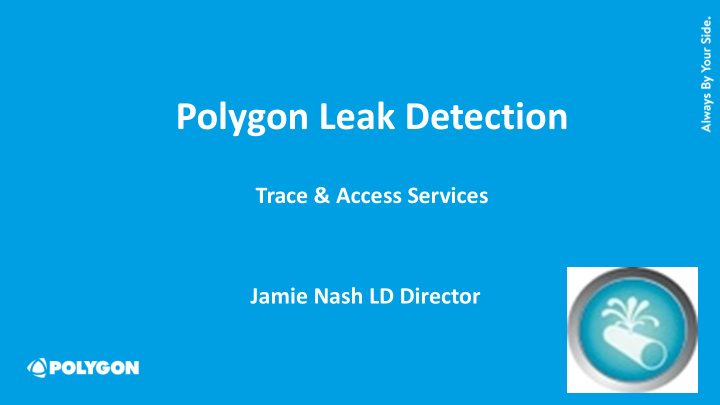



Polygon Leak Detection Trace & Access Services Jamie Nash LD Director
Polygon Trace & Access Agenda • Introduction to LD • How we find leaks • Case study • IOT – Preventative Technology • Questions
Flaws in traditional methods of finding leaks • Traditional methods are often destructive, labour intensive and unsuccessful resulting in numerous “dry holes ” • Secondary damage can be caused during location of the original leak (damage to the building fabric and hidden pipe work) • Destructive methods can not identify smaller leaks (disguised by larger leakages) imposing additional costs for second and subsequent visits • Poor claim journey and multiple failure demand likely.
How do Polygon find leaks? • Polygon use technology to locate leaks non- destructively • Reducing costs of access/excavation • Reducing reinstatement costs Methods of tracing leaks non-destructively • Acoustics: Noise or Infra-red emissions Acoustics “ bodysound ” • Infra-red: Energy patterns • Tracer Gas Tracer Gas
Acoustic Sound Profiling • Works on the principle of body sound (noise) • Leaks are accurately detected through pipe mapping, pre-location and ground sound profiling • Tests to 10ft through any surface (concrete, wood, soil, Tarmac etc.) • Used on internal or external pressurised systems • Distribution or network pipes • Main Supply • Mains feed (internal)
Thermography • Works on the principle of visual patterns of energy loss (heat and water) • Leaks detected by plotting temperature changes of the hot pipe work against the cooler surrounds • Large surface areas can be assessed in shorter timeframe • ‘Hot spots’ are often the area of leakage (to the trained eye)
Tracer Gas • Used in situations where leaks are particularly difficult to locate • Technician decommissions system, and purges with specialist gas • Gas detected above the ground as it escapes, locating leak • Used on internal or external applications; • Distribution pipe work • Main Supply • Mains feed or heating systems (internal) • Flat Roofs
Supporting Methods • Moisture Measurement • Water analysis • Salts analysis • Dye testing • Video Endoscopes
Case Study’s
Case Study Scenario : • 65m2 tiled floor, HNW Individual • Customer first noticed water damage to skirting board • Customer stressed they wanted minimal disruption • Customer advised by plumber to use specialist leak detection service • Polygon instructed to conduct survey under Trace & Access cover • Leaking pipe from heating circuit located under kitchen floor • Floor tiles carefully removed with minimal disruption • Concrete slab excavated to expose leaking pipe • Leak fixed, and hole made safe • Time taken – 1 day
Case Study Heating/Hot Water Pipe Leaks • Thermal cameras are very effective on identifying where there are central heating pipes, and where there are hotspots (leaks) • Thermal tracking is most effective where the pipes are in concrete or inaccessible voids (e.g. floating floors) • Effective even when there is no apparent damage to the solid wooden floor. Hotspot on the floor where the heating No visible damage on the wooden floor pipes are
Case Study External Leak Detection Problem • Homeowner received a water bill for £3,800 • Initial investigation by water company identified a leak between internal stop tap and the water meter located on the roadside • The solution at that stage would have been to dig up the driveway to locate the leak.
Case Study External Leak Detection Solution • Polygon’s methods to locate the leak included acoustic profiling and tracer gas • The external mains feed pipe was pressurised using a standard mix of 5% hydrogen and 95% nitrogen tracer gas • The drive was then walked using a sledge to detect the gas escaping from the ground. Result • Leak located within 2 hours and fix made • Non-destructive survey testing ensured that excavation work was minimised • Speed of detection and subsequent repair resulted in less interruption to the property owner and potential savings if the leak had been left.
Case Study The Cube Spa Birmingham Problem • On-going issues with a leak previously suspected that this could be the Saniflow • Standing water within the false floor void customer constantly pumping waste water from the void • Treatment rooms effected in the basement area • High moisture levels found throughout the basement area • Mould Appearing in the treatment rooms • Business interruption due to the facilities out of use
Case Study The Cube Spa Birmingham Solution • Polygon conducted moisture profiling along with dye testing and video endoscopes to identify areas of interest • Waste pipes capped and isolated to carry out further testing • 1 treatment room isolated and further inspections to the floor void conducted Result • Leak to the waste pipe identified and second leak to the air conditioning unit within the ceiling void identified. • PolygonVatro to implement drying programme
Any Questions? Before you make that first hole …
What our customers say about us……... Trust Score 9.3 out of 10 93% excellent 7% Great 5 star Rating 158 visits to our profile 102 Reviews 89% invited reviews 11% Organic Reviews Personal response with all reviews This company is simply amazing. They turned up on time found the underground leak, fixed it, cleaned up and left! I would recommend them to anyone 10/10. Thanks for saving our Christmas – Matthew in Birmingham
Polygon Trace & Access – Contacts… Polygon Trace & Access technical helpdesk 0330 3322958 Polygon T&A website www.polygonleakdetection.com For instructions: Tel 0330 3322958 Email uk_leakdetection@polygongroup.com Polygon T&A Operational contacts: Natalie Hicks – T&A Claims Manager 07717 653653 Bob Green – T&A South Ops Manager 07786 708831 Lawrence Duffy – T&A North Ops Manger 07796 548562 Jamie Nash – Director 07774 885096
Recommend
More recommend